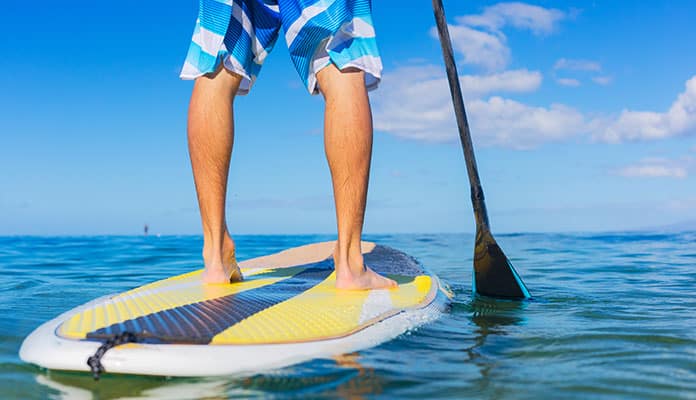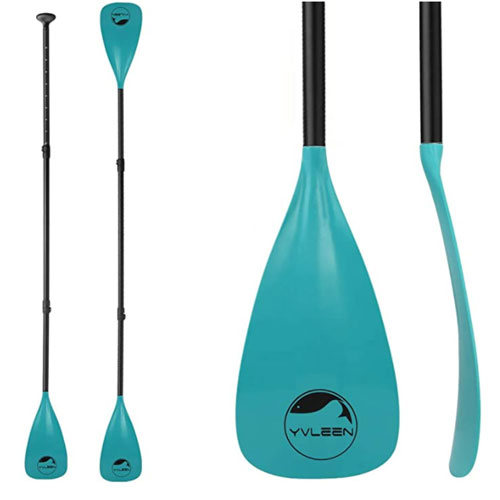
-
1.
-
2.
-
3.
-
4.
-
5.
Whether it’s the heat of summer or the chilly feeling of fall, stand up paddle boarding tends to be the most favorite activity for water sports lovers. However, the tricky part with SUP is that this fun activity can be easily spoiled by the wrong equipment.
Among many other necessary tools, the best sup paddles are the most critical gear to have by your side to enjoy your day out fully. Durability, strength, and versatility are some of the many qualities that every sensible paddler should look for before deciding which sup paddle to buy.
Thankfully, we have compiled the list of the best sup paddles the market offers to ensure that you get the most from your day at the lake. Hopefully, one of these top players is the one that you are looking for.
OUR TOP PICK
SUP Supply 3 Piece Adjustable Alloy
- Stand Out Features - Why We Love It
- Allows quick adjustments for paddler’s height
- Ability to withstand a lot of punishment
- They float in sea or freshwater
- You can break it down in seconds and toss it at the back of your car
- Marine-grade aluminum increases the level of durability
- High quality locking mechanism
Weight: 2lbs and 2 oz.
Color: Black
Level: Beginner
Adjustable Range: 67 – 85 Inches
Shaft Construction: Aircraft-Grade Aluminum
Blade Construction: Nylon
EDITORS CHOICE
Abahub 3-Piece Adjustable Alloy
- Stand Out Features - Why We Love It
- Replacement and refund policy available
- Floats in all waters
- Easy to break down to 3 parts, easy to store, and convenient to carry
- It gives power and stability with its concave grooves blade shape
- Has been tested rigorously before released to the market
Weight: 35oz
Color: Yellow, Blue, Black
Level: Beginner
Adjustable Range: 68- 84 inches
Shaft Construction: Aluminum Alloy
Blade Construction: 40% Fiberglass 60% Polypropylene – UV stable
BEST VALUE
BPS Adjustable Alloy 2 Piece
- Stand Out Features - Why We Love It
- Comes with a blade cover
- Ergonomic T-shape handle for a comfortable palm grip
- Angled blade to maximize efficiency and stroke power
- Designed and tested by professional paddlers
- Comes with a 1-year guarantee
- High quality locking mechanism
Weight: 2lbs
Color: Pink, Blue, Green, Grey, Brown, White, Grey
Level: All
Adjustable Range: 70.86 – 83.85 inches
Shaft Construction: Aluminum
Blade Construction: Nylon Composite
- Stand Out Features - Why We Love It
- Ideal for paddlers above the height of 5 feet
- It can endure serious punishment
- It takes under 20 seconds to setup
- The bag is made with a tough nylon exterior and close-cell foam padding
- The heat-reflective aluminum inner lining of the bag protects the paddle from getting too hot
Weight: 1.6 lbs
Color: Black
Level: Beginner
Adjustable Range: 72 – 86 inches
Shaft Construction: Fiberglass
Blade Construction: 70% Nylon, 30% Fiberglass
YVLEEN 4-Piece Alloy Adjustable
- Stand Out Features - Why We Love It
- Floats in fresh and saltwater
- It can be converted into a kayak paddle if needed
- Comes complete with a full paddle bag to protect it from scratches
- Made of high-quality aluminum alloy, and light in weight
- Comes in a reasonable price tag compared to paddles with similar features
Weight: 2 lbs
Color: Blue, Black, Grey, White, Green, Gray, Lake Blue
Level: All
Adjustable Range: 68 – 85 inches
Shaft Construction: Not specified
Blade Construction: 40% Fiberglass 60% Polypropylene
Abahub 3- Piece Carbon Fiber
- Stand Out Features - Why We Love It
- Adjustable from 67’’ to 86’’
- Replacement and refund warranty
- Double-concave blade design increases performance
- Carbon fiber shaft protects the paddle from breaking
- Comes from a brand with over 10 years of experience
Weight: 30 oz
Color: Black, Blue, Grey
Level: Beginner & Intermediate
Adjustable Range: 67 – 86 inches
Shaft Construction: Carbon Fiber Composite
Blade Construction: 40% Fiberglass 60% Polypropylene – UV stable
- Key Features
- Travel friendly with the longest side being around 66 inches
- Guaranteed to float in both salt and freshwater
- Ergonomically designed handle
- Offers a huge height range, therefore perfect for children and adults alike
- Beautiful color range
- High quality locking mechanism
Weight: 2.2lbs
Color: Arctic White, Lilac Grey, Mint Green, Red Brown, Rose Pink, Snorkel Blue
Level: All
Adjustable Range: 71 – 83 inches
Shaft Construction: Aluminium
Blade Construction: Nylon Composite
- Stand Out Features - Why We Love It
- Easy to assemble thanks to 3 piece design
- Adjustable handle and length upon preference
- Comes with a carry bag with a heat reflective inner lining
- Always floats (when the parts are together)
- Tested and designed in New Zealand
Weight: 2.1 lbs
Color: Blue, Pink, Brown, Green, Grey
Level: All
Adjustable Range: 70.86 – 83.85 inches
Shaft Construction: Rigid Aluminium
Blade Construction: Reinforced Nylon Composite
Swimline Solstice Aluminum
- Stand Out Features - Why We Love It
- 3-piece adjustable compression system
- Ergonomic T-shaped handle
- Budget-friendly option
- It extends longer than most paddles on the market
- Ideal for children and adults alike
Weight: 2.6lbs
Color: Black
Level: All
Adjustable Range: 64 – 84 inches
Shaft Construction: Aluminium
Blade Construction: Nylon Composite
- Stand Out Features - Why We Love It
- Fiberglass fiber lite blade
- Ideal for small paddlers and beginners
- Slim diameter fiber shaft
- Made from recycled materials
- Easy-to-use locking mechanism
Weight: 1lb 8 oz
Color: Green
Level: Beginner
Adjustable Range: 60 to 82 inches
Shaft Construction: Fiberglass
Blade Construction: Fiberglass Fibrlite
How To Choose The Best Sup Paddle – Buying Guide

Length
The definition of the best sup paddle changes from person to person. If you are paddling recreationally, then you want a medium size paddle, so aim for 7-12% above your height. If you are racing, then you need to aim for a paddle which is 10-15% above your height. Here is a quick guide on how to choose the length of your paddle:
- Stand the paddle up vertically. Make sure the tear-drop-shaped blade touches the ground
- Reach an arm up above your head and see where it is on the paddle
- The T-grip handle will rest in the bend of your wrist. You can adjust the length of the shaft as you see fit
- We recommend you aim for a paddle with a length that is roughly 8-12 inches longer than you are
Palm Grips
While choosing your style of grip, there are many things to think about. We recommend you find a grip that you will be able to hold onto for hours at a time. Look for ergonomically-crafted grips with good hand positions.
Storage
If you have limited space, it is best to look for a paddle that comes apart. Most multi-piece paddles can be broken down into three pieces, making them very easy to store.
You might also like: Paddle Board Leashes
Blade Material
Aluminum is one of the strongest materials while remaining lightweight and affordable. Carbon Fiber, on the other hand, is the lightest of all the blade materials. Fiberglass fits in between. It is lighter than aluminum and stronger, but not as strong and light as carbon fiber. Fiberglass and carbon fiber enhances the quality, whereas aluminum increases its utility. Before choosing the material, it is better to answer the below questions:
- How often will you be paddling? Opt for a lighter paddle if you will be paddling often.
- What is your budget? Lightweight materials, like carbon fiber and fiberglass, are more expensive than heavier paddles, like aluminum and plastic.
- Do you have a muscle or joint injury? If you have experienced a shoulder, arm, or wrist injury before, it is better to buy a paddle with some flex.
Size
The blade size determines the resistance through the water and the energy you expend. A large blade takes more energy to pull through the water. Medium blades, on the other hand, offer less resistance while small blades offer the least resistance. We recommend choosing the size of your paddle depending on your weight, here is a quick guide:
- Small/medium (less than 150 lbs.): 80–90 sq. in.
- Medium/large (150 – 200 lbs.): 90–100 sq. in.
- Large/X (200+ lbs.): 100–120 sq. in.
Blade Shape
A square blade with more surface area gives you more power whereas, rounded blades move easily through the water. There are two choices of blade profile when you look at it from the end. A flat blade is flat and generates more power through the water whereas the dihedral blade is a better option for beginners as it moves through the water more smoothly.
Blade Angle
Around 10% is the most common angle, but it can be as little as 6% and as big as 12%. Before deciding, we recommend you try some of the paddles we’ve reviewed in our list of the best sup paddles.
FAQs

Q: Why Are Sup Paddles Angled?
SUP paddles are angled for two reasons. The first is to allow you to move the blade through the water conveniently and with less force. The second reason is to prevent water from being lifted when you are pulling the blade through the water.
Q: How To Size Sup Paddles?
The general rule is that a paddle's length should be more than your height. About 8 inches taller is the standard. If you are a beginner and have any problems with joints or your back, it is best to go with a longer paddle.
Q: Do Sup Paddles Float?
Yes, most of the modern paddles float.
Q: How To Use Sup Paddles?
When you hold your paddles sup, you have one hand on the top of your paddle and the other hand lowers down the paddle. If you stand with the paddle in the water, and one hand on the top of the paddle, take note of the angle of your arm and use the same angle for your other arm to lower down the paddle.
Q: How Long Are Sup Paddles?
SUP paddle comes in all lengths and sizes. Adjustable sup paddles are designed for the smallest kids and the tallest adults in mind.
Globo Surf Overview
To sum up, an overwhelming amount of sup paddle reviews agree that having a lightweight, 3 pieces adjustable paddle is the key. Of course, it eventually comes down to your personal choice whether you will be using your paddle often or seldom. Hopefully, one of the products we have reviewed on our list of the best sup paddles is the right one for you.
Paddle boards Sup Fishing Reviews:
Do you love to stand up paddle boarding? Have one of the best sup paddles on our list? Let us know how you like it in the comment section below.












